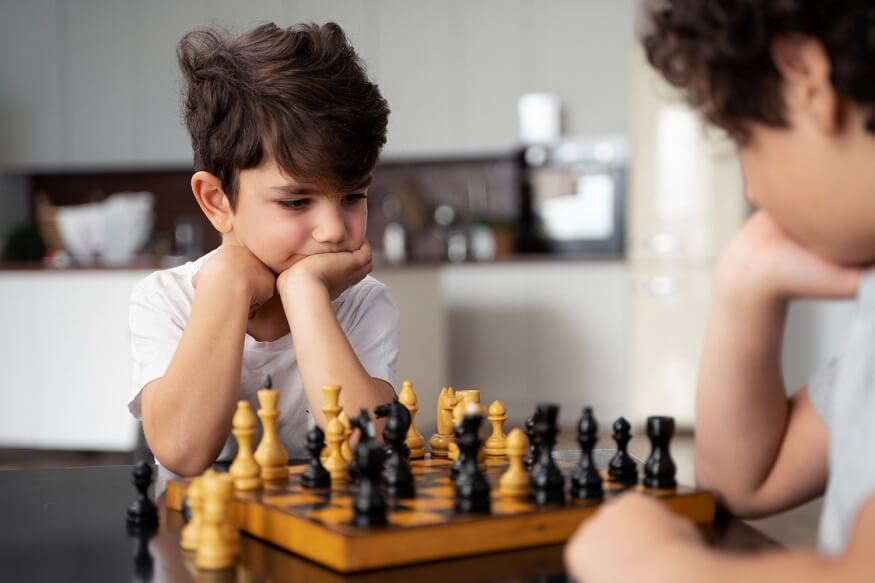Chess is a popular indoor strategy-based two-player board game. It is played with two sets of chess pieces, White and Black on a chess board consisting of 64 squares in a 8 x 8 square configuration. Sixteen white chess pieces compete against another set of sixteen black chess pieces. The context of the game is in the form of two warring armies. For each side (or colour) the sixteen pieces comprise;
- 1 King
- 1 Queen
- 2 Rooks
- 2 Knights
- 2 Bishops
- 8 pawns
Setup
The game is played on a square board consisting of 8 rows (or ranks) and 8 columns (or files) giving rise to 64 squares. White and black squares alternate in sequence. The game starts with the two players sitting on opposite sides of the chess board. The first two rows of squares on each side are organised as follows:
– First row (from left to right) is organised in the sequence – rook, knight, bishop, queen, king, bishop, knight, rook
– Second row will have all the 8 pawns
In competitive games, the competition organisers typically allocate chess piece colours (white or black). Players can choose colours mutually or by tossing a coin in informal games.
Also Read: Reasons why playing chess is beneficial for children
Moves
The player playing with the White pieces makes the first move. Each player makes a move alternatively, except in a casting scenario where two pieces are moved simultaneously. Each piece moves into an empty square or a square occupied by the opponent’s piece, thus taking the opponent’s piece out of play. Except for the knight, all other pieces can only move along paths that are unoccupied and cannot leap over other pieces. Making a move is essential for each player and cannot be passed. Each of the pieces has its movement patterns. Below is the summary of the movement pattern of each piece on the chessboard.
– Queen: The queen enjoys the most flexibility of movement among all chess pieces. The queen can move any number of steps to its left or right, front or back, or diagonally.
– King: The king can move only one square to its left or right, front or back, or diagonally, in any of the squares immediately adjacent to its currently occupied square. This creates a potential of 8 possible moves for the king. The king is the most important piece on the board and the game ends when the king is taken out of the game. Thus protecting your king is the key objective of the game of chess.
– Rook: The rook can move any number of squares but either to its right/left or towards front or back. The rook cannot leap over other pieces.
– Bishop: The bishop can move any number of squares but only into diagonally aligned squares. The bishop cannot also leap over other pieces.
– Knight: A knight can only move “two and a half steps” in one move, forming an “L” shaped movement pattern. For example, two steps along the rank and then one step along the file. Knight is the only piece that can leap over other pieces.
– Pawn: The pawn can only move one unoccupied step forward, except for the first move where a white pawn can move two steps forward if the steps are unoccupied. A pawn can capture an opponent’s piece if present in any of the adjacent squares diagonally in the forward direction.
Check and Checkmate
The objective of each player is to capture the opponent’s King or checkmate the opponent. When the King is under attack and can be captured in the next one move, the King is said to be in “Check”. In informal settings, there is a practice of the attacking player announcing “check” to warn the opponent. However, there is no such mandate in professional games and tournaments. The player whose King is in check is now supposed to take the king out of danger of being captured in the next move. If the player fails to take the king out of danger, the game ends with the king being captured, called a checkmate.
There are various ways in which the defending player can save their king from the check position.
– Capture the opponent’s check piece itself, thus taking away the root cause of the attack.
– Moving the king into a position where it is no longer in check.
– Bringing in another piece in the path of the opponent’s check piece to obstruct the movement of the check piece towards the king.
Also Read: World Chess Day: 20 Interesting facts about chess
Tactics and Strategies
The professional game of chess is highly competitive with a myriad of complex tactics and strategies that players employ to outsmart their opponents. Chess is regarded as a game of intelligence. Historically, traditional foes USA and Russia used chess to earn bragging rights by trying to outsmart each other in chess tournaments. Popular tactics and strategies followed in chess are as follows.
Opening with the right pawn
Open with the pawn in front of either the king or the queen thus opening up the space for the king and the queen to move freely as and when required to attack, defend, and counterattack. This also opens up space for the bishop to come into play and inflict significant damage on the opponent. The idea is to take the pawns out of the way so that these pieces can move freely.
Play your Knight and Bishop
Knight and Bishop are the most potent attack tools in the game of chess. It is advisable to bring them into play as early as possible. Once the knight and bishop are in open spaces they can inflict maximum damage on the opponent’s chess pieces.
Read the mind of your opponent
Chess is not just about minding your moves, but also keenly observing and analysing your opponent’s moves. A good chess player can think and visualise the chess board many moves into the future. A good chess player can read into their opponent’s mind and sense what strategy their opponent is going with.
Also Read: Benefits of Sports for Students and Children
Castle Early into the game
Castling is the move where you safeguard your king and set your rook free to get into the play. It is advised to castle as early as possible into the game so that you can ensure safety for your king while also setting the rook free to attack your opponent.









